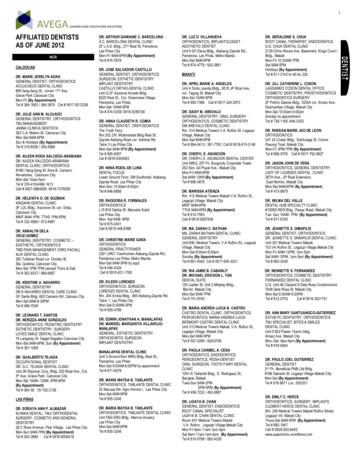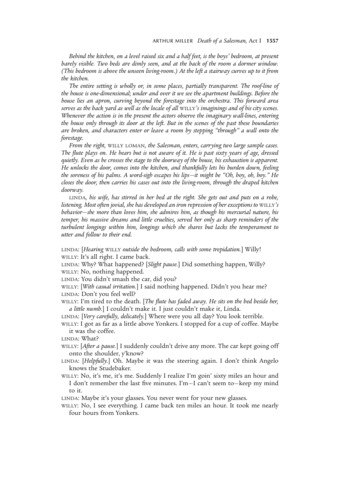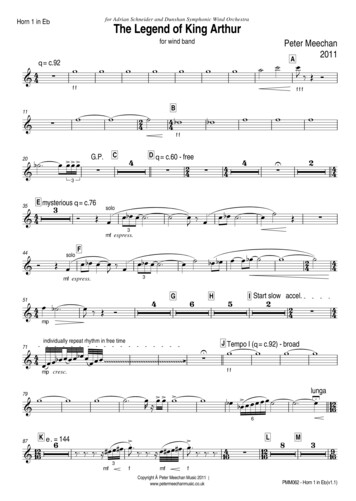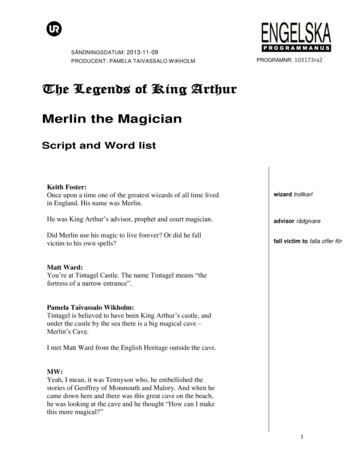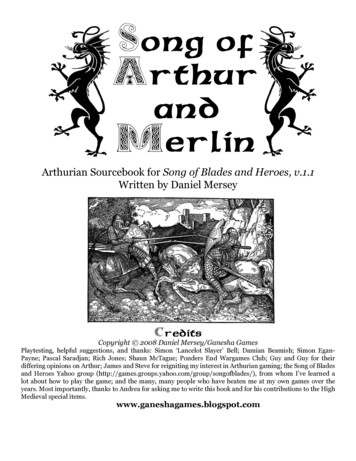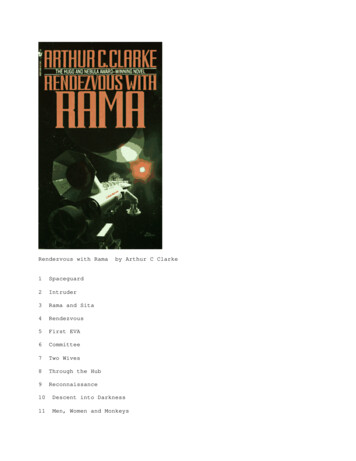
Transcription
Rendezvous with Rama1Spaceguard2Intruder3Rama and Sita4Rendezvous5First EVA6Committee7Two Wives8Through the Hub9Reconnaissanceby Arthur C Clarke10Descent into Darkness11Men, Women and Monkeys
12The Stairway of the Gods13The Plain of Rama14Storm Warning15The Edge of the Sea16Kealakekua17Spring18Dawn19A Warning from Mercury20Book of Revelation21After the Storm22To Sail the Cylindrical Sea23NY, Rama24Dragonfly25Maiden Flight26The Voice of Rama27Electric Wind28Icarus29First Contact30The Flower31Terminal Velocity32The Wave33Spider34His Excellency Regrets .35Special Delivery36Biot Watcher37Missile38General Assembly39Command Decision
40Saboteur41Hero42Temple of Glass43Retreat44Space Drive45Phoenix46InterludeCHAPTER ONE - SpaceguardSooner or later, it was bound to happen. On 30 June 1908,Moscow escaped destruction by three hours and fourthousand kilometres - a margin invisibly small by thestandards of the universe. Again, on 12 February 1947,yet another Russian city had a still narrower escape,when the second great meteorite of the twentieth centurydetonated less than four hundred kilometres from Vladivostok, with an explosion rivalling that of the newlyinvented uranium bomb.In those days, there was nothing that men could do toprotect themselves against the last random shots in thecosmic bombardment that had once scarred the face ofthe Moon. The meteorites of 1908 and 1947 had struckuninhabited wilderness; but by the end of the twentyfirst century, there was no region left on Earth that couldbe safely used for celestial target practice. The humanrace had spread from pole to pole. And so, inevitably.At 09.46 GMT on the morning of 11 September, in theexceptionally beautiful summer of the year 2077, most ofthe inhabitants of Europe saw a dazzling fireball appearin the eastern sky. Within seconds it was brighter thanthe sun, and as it moved across the heavens - at first inutter silence - it left behind it a churning column of dustand smoke.Somewhere above Austria it began to disintegrate, producing a series of concussions so violent that more than amillion people had their hearing permanently damaged.They were the lucky ones.Moving at fifty kilometres a second, a thousand tons ofrock and metal impacted on the plains of northern Italy,destroying in a few flaming moments the labour of centuries. The cities of Padua and Verona were wiped fromthe face of the earth; and the last glories of Venice sankfor ever beneath the sea as the waters of the Adriatic came -
thundering landwards after the hammer-blow from space.Six hundred thousand people died, and the total damage was more than a trillion dollars. But the loss to art, tohistory, to science - to the whole human race, for the restof time - was beyond all computation. It was as if a greatwar had been fought and lost in a single morning; andfew could draw much pleasure from the fact that, as thedust of destruction slowly settled, for months the wholeworld witnessed the most splendid dawns and sunsetssince Krakatoa. After the initial shock, mankind reacted with a determination and a unity that no earlier age could haveshown. Such a disaster, it was realized, might not occuragain for a thousand years - but it might occur tomorrow. And the next time, the consequences could be evenworse.Very well; there would be no next time.A hundred years earlier a much poorer world, with farfeebler resources, had squandered its wealth attempting todestroy weapons launched, suicidally, by mankindagainst itself. The effort had never been successful, butthe skills acquired then had not been forgotten. Nowthey could be used for a far nobler purpose, and on aninfinitely vaster stage. No meteorite large enough tocause catastrophe would ever again be allowed to breachthe defences of Earth.So began Project SPACEGUARD. Fifty years later - andin a way that none of its designers could ever have anticipated - it justified its existence.CHAPTER TWO - IntruderBy the year 2130, the Mars-based radars were discoveringnew asteroids at the rate of a dozen a day. The SPACEGUARD computers automatically calculated their orbits,and stored away the information in their enormous memories, so that every few months any interested astronomercould have a look at the accumulated statistics. Thesewere now quite impressive.It had taken more than a hundred and twenty years tocollect the first thousand asteroids, since the discovery ofCeres, largest of these tiny worlds, on the very first day ofthe nineteenth century. Hundreds had been found andlost and found again; they existed in such swarms thatone exasperated astronomer had christened them 'verminof the skies'. He would have been appalled to know thatSPACEGUARD was now keeping track of half a million.Only the five giants - Ceres, Pallas, Juno, Eunomia andVesta - were more than two hundred kilometres in diameter; the vast majority were merely oversized boulders
that would fit into a small park. Almost all moved inorbits that lay beyond Mars; only the few that came farenough sunwards to be a possible danger to Earth werethe concern of SPACEGUARD. And not one in a thousand ofthese, during the entire future history of the solar system,would pass within a million kilometres of Earth.The object first catalogued as 31/439, according to theyear and the order of its discovery, was detected whilestill outside the orbit of Jupiter. There was nothing unusual about its location; many asteroids went beyondSaturn before turning once more towards their distantmaster, the sun. And Thule II, most far-ranging of all,travelled so close to Uranus that it might well have beena lost moon of that planet.But a first radar contact at such a distance was unprecedented; clearly, 31/439 must be of exceptional size.From the strength of the echo, the computers deduced adiameter of at least forty kilometres; such a giant had not- been discovered for a hundred years. That it had beenoverlooked for so long seemed incredible.Then the orbit was calculated, and the mystery wasresolved - to be replaced by a greater one. 31/439 was nottravelling on a normal asteroidal path, along an ellipsewhich it retraced with clockwork precision every fewyears. It was a lonely wanderer between the stars, makingits first and last visit to the solar system - for it was moving so swiftly that the gravitational field of the sun couldnever capture it. It would flash inwards past the orbits ofJupiter, Mars, Earth, Venus and Mercury, gaining speed as it did so, until it rounded the sun and headed out onceagain into the unknown.It was at this point that the computers started flashingtheir 'Hi there! We have something interesting' sign,and for the first time 31/439 came to the attention ofhuman beings. There was a brief flurry of excitement atSPACEGUARD Headquarters, and the interstellar vagabondwas quickly dignified by a name instead of a mere number. Long ago, the astronomers had exhausted Greek andRoman mythology; now they were working throughthe Hindu pantheon. And so 31/439 was christenedRama.For a few days, the news media made a fuss of thevisitor, but they were badly handicapped by the sparsityof information. Only two facts were known about Rama- its unusual orbit, and its approximate size. Even thiswas merely an educated guess, based upon the strength ofthe radar echo. Through the telescope, Rama still appeared as a faint, fifteenth magnitude star - much toosmall to show a visible disc But as it plunged in towardsthe heart of the solar system, it would grow brighter andlarger, month by month; before it vanished for ever, theorbiting observatories would be able to gather more pre-
cise information about its shape and size. There wasplenty of time, and perhaps during the next 'few yearssome spaceship on its ordinary business might be routedclose enough to get good photographs. An actual rendezvous was most unlikely; the energy cost would be far toogreat to permit physical contact with an object cuttingacross the orbits of the planets at more than a hundredthousand kilometres an hour.So the world soon forgot about Rama; but the astronomers did not. Their excitement grew with the passing months, as the new asteroid presented them withmore and more puzzles.First of all, there was the problem of Rama's lightcurve. it didn't have one.All known asteroids, without exception, showed a slowvariation in their brilliance, waxing and waning within aperiod of a few hours. It had been recognized for morethan two centuries that this was an inevitable result oftheir spin, and their irregular shape. As they toppled endover end along their orbits the reflecting surfaces theypresented to the sun were continually changing, andtheir brightness varied accordingly.Rama showed no such changes. Either it was not spinning at all or it was perfectly symmetrical. Both explanations seemed equally unlikely.There the matter rested for several months, becausenone of the big orbiting telescopes could be spared fromtheir regular job of peering into the remote depths ofthe universe. Space astronomy was an expensive hobby,and time on a large instrument could easily cost a thousand dollars a minute. Dr William Stenton would neverhave been able to grab the Farside two-hundred-metrereflector for a full quarter of an hour, if a more important programme had not been temporarily derailed bythe failure of a fifty cent capacitor. One astronomer's badluck was his good fortune.Bill Stenton did not know what he had caught untilthe next day, when he was able to get computer time toprocess his results. Even when they were finally flashed onhis display screen, it took him several minutes to understand what they meant.The sunlight reflected from Rama was not, after all,absolutely constant in its intensity. There was a verysmall variation - hard to detect, but quite unmistakable,and extremely regular. Like all the other asteroids, Ramawas indeed spinning. But whereas the normal 'day' for anasteroid was several hours, Rama's was only four minutes.Dr Stenton did some quick calculations, and found ithard to believe the results. At its equator, this tiny world
must be spinning at more than a thousand kilometres anhour; it would be rather unhealthy to attempt a landinganywhere except at the poles. The centrifugal force atRama's equator must be powerful enough to flick anyloose objects away from it at an acceleration of almost onegravity. Rama was a rolling stone that could never havegathered any cosmic moss; it was surprising that such abody had managed to hold itself together, and- had notlong ago shattered into a million fragments.An object forty kilometres across, with a rotation periodof only four minutes - where did that fit into the astronomical scheme of things? Dr Stenton was a somewhatimaginative man, a little too prone to jump to conclusions.He now jumped to one which gave him a very uncomfortable few minutes indeed.The only specimen of the celestial zoo that fitted thisdescription was a collapsed star. Perhaps Rama was adead sun - a madly spinning sphere of neutronium, everycubic centimetre weighing billions of tons.At this point, there flashed briefly through Dr Stenton'shorrified mind the memory of that timeless classic, H. G.Wells's The Star. He had first read it as a very small boy,and it had helped to spark his interest in astronomy.Across more than two centuries of time, it had lost noneof its magic and terror. He would never forget the imagesof hurricanes and tidal waves, of cities sliding into thesea, as that other visitor from the stars smashed intoJupiter and then fell sunwards past the Earth. True, thestar that old Wells described was not cold, but incandescent, and wrought much of its destruction by heat. Thatscarcely mattered; even if Rama was a cold body, reflecting only the light of the sun, it could kill by gravity aseasily as by fire.Any stellar mass intruding into the solar system wouldcompletely distort the orbits of the planets. The Earthhad only to move a few million kilometres sunwards - orstarwards - for the delicate balance of climate to bedestroyed. The Antarctic icecap could melt and flood all:low4ying land; or the oceans could freeze and the wholeworld be locked in an eternal winter. Just a nudge ineither direction would be enoughThen Dr Stenton relaxed and breathed a sigh of relief.This was all nonsense; he should be ashamed of himself.Rama could not possibly be made of condensed matter.No star-sized mass could penetrate so deeply into thesolar system without producing disturbances whichwould have betrayed it long ago. The orbits of all theplanets would have been affected; that, after all, was howNeptune, Pluto and Persephone had been discovered.No, it was utterly impossible for an object as massive as adead sun to sneak up unobserved.
In a way, it was a pity. An encounter with a dark starwould have been quite exciting.While it lasted.CHAPTER THREE - Rama and SitaThe extraordinary meeting of the Space Advisory Council was brief and stormy. Even in the twenty-second century, no way had yet been discovered of keeping elderlyand conservative scientists from occupying crucial administrative positions. Indeed, it was doubted if the problem ever would be solved.To make matters worse, the current Chairman of theSAC was Professor (Emeritus) Olaf Davidson, the distinguished astrophysicist. Professor Davidson was not verymuch interested in objects smaller than galaxies, andnever bothered to conceal his prejudices. And though hehad to admit that ninety per cent of his science was nowbased upon observations from space-borne instruments,he was not at all happy about it. No less than threetimes during his distinguished career, satellites speciallylaunched to prove one of his pet theories had done precisely the opposite.The question before the Council was straightforwardenough. There was no doubt that Rama was an unusualobject - but was it an important one? In a few months itwould be gone for ever, so there was little time in whichto act. Op
Rama's equator must be powerful enough to flick any loose objects away from it at an acceleration of almost one gravity. Rama was a rolling stone that could never have gathered any cosmic moss; it was surprising that such a body had managed to hold itself together, and- had not long ago shattered into a million fragments.





